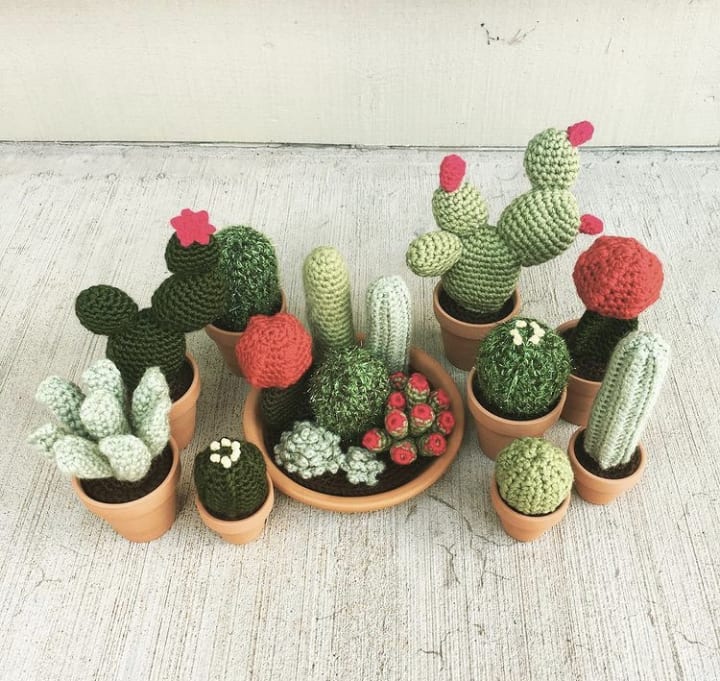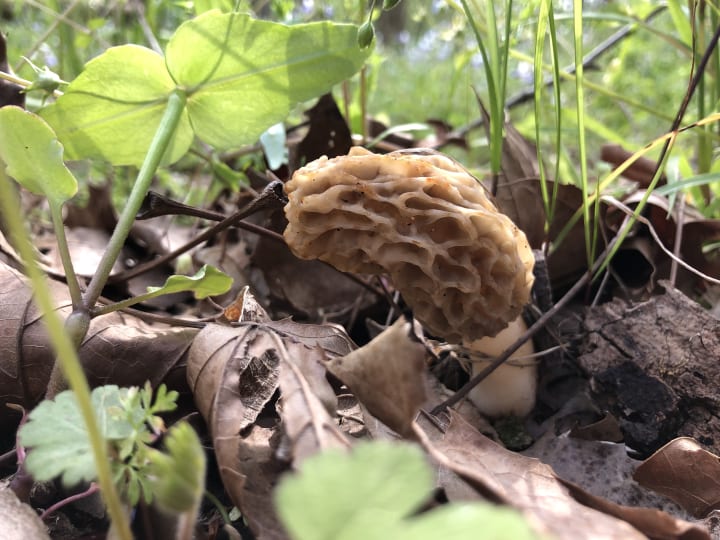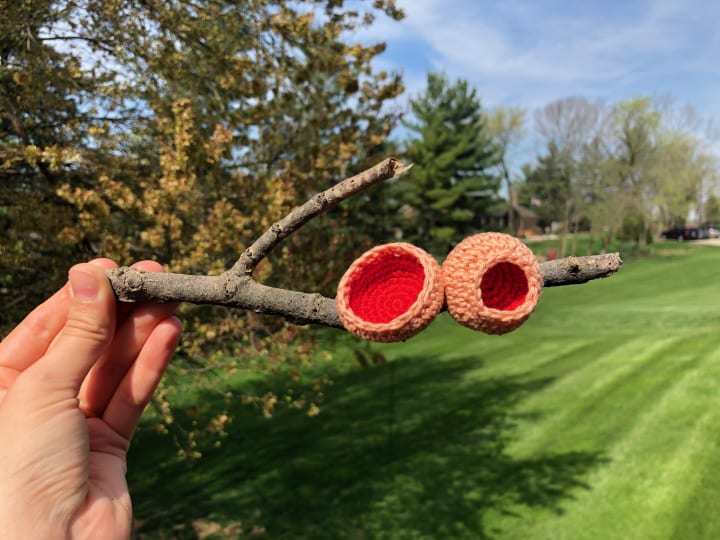Crocheting Nature
The joy of making handmade versions of the natural world

I'm not really sure when it started. I don't remember waking up one day and thinking, "I'm going to crochet a version of every organism I find in the woods that really speaks to me." I never planned to write multiple crochet patterns for very specific mushrooms, or to construct a cicada with yarn and plastic, but I suppose the past year has taught us all surprising things about ourselves. My surprising thing, apparently, is that I love to crochet mini versions of the natural world.
While I only recently became interested in foraging mushrooms and plants, I have been crocheting since about age 10. Both my mother and grandmother taught me—my mother specializing in baby afghans and my grandmother notorious for her upcycled totes made out of plastic bags. I enjoyed it when I was a kid, but it didn't really stick long term—until four years ago.
That summer, something prompted me to remember those long golden afternoons spent with my grandmother in our sunroom, those evenings watching my mother crochet intricate afghans for friends' babies. I thought it would be fun to revisit an old skill. So I picked up a hook and yarn, and I haven't looked back since.
I revamped my interest in crocheting by starting a sweater. The stitches began to feel familiar, and I began working on it every chance I got. Soon, though, I became distracted from this garment making when I stumbled upon some delightful crochet patterns for cacti and succulents.
Game over.

Once I discovered them, all I wanted to do was make little crocheted plants. The patterns included instructions for making your own pot, but I wanted to have real terra cotta. I made my own pattern for an insertable soil pod that fit 3-inch mini pots perfectly, and I took them to a community yard sale thinking I might sell a handful of them. I sold out.
I soon began selling them at a local tea shop where I lived in Flagstaff, Arizona. Considering the location, they were a hit, and I was hooked. Pun intended.
I've made many crocheted cacti and succulents since then. I love the way they look in their little pots: different shades of green, different shapes, the occasional red top or pink flower poking out among the leaves. I love seeing people's faces at craft shows when they realize that the crocheted versions are not, in fact, alive, and that they have found a plant that they can't kill.

The Obsession Grows: Morel Season 2020
Since I first rediscovered my interest in crocheting a few years ago, I have expanded my skills to other items: stuffed animals, freeform crochet clothing, cardigans, hats, mittens, socks. But nothing brings me joy like crocheting handmade versions of real-life organisms, such as plants and mushrooms.
During the pandemic, as I transitioned to working from home, I found myself with plenty of time both to crochet and to try new things. I had read a book about the wild world of mushroom foraging in January of 2020, and I thought that this particular spring would be a good time to go out into the woods and try my hand at identifying and harvesting edible mushrooms, since I had the time.
The obvious starting point for the neophyte forager is the morel. It's easy to identify, it has very few true lookalikes, and it is one of the most delicious things to ever grace a tastebud. The downside of morel hunting is that they can be very temperamental; they only grow under certain trees, in specific soils, in very picky environments.
I alternated my time between crafting at home and prowling the hills for these prized mushrooms. I became more skilled at recognizing elm, cottonwood, ash, and tulip poplar trees, which are associated with morels in the Eastern United States. I went to park after park, trail after trail. I didn't find morels immediately, but I did start to learn other fungal friends: Sarcoscypha, the red elf cup or scarlet cup fungus. Trametes versicolor, turkey tail. Cerioporus squamosus, pheasant back. Tremella mesenterica, witches' butter.
I learned more about the plants in the woods, too. Trout lily is one of the first flowers to appear in the early spring, along with scarlet cup mushrooms. Later, the trillium starts to bloom, its delicate flower perched in the center of three leaves. I learned to identify cutleaf toothwort, Dutchman's breeches, and blue phlox. Every time I went into the woods, I learned something new. The earth began to wake up from winter, the cool air flowing into my lungs. Each time I left, I felt bestowed with a new gift of knowledge and life.

The foraging season wore on, with no morels. I did, however, find a good amount of pheasant back, an edible polypore mushroom that smells pleasantly of cucumber. Though a bit tough, these mushrooms cook up into a nice stir fry with the right ingredients. Still, I yearned for morels.
Since I had found none, and since my mania was reaching a peak, I was struck with an idea: If I can't find any morels in the woods, why don't I crochet one?
That's exactly what I did. I found some scrap yarn, sketched out an idea, and set to work crocheting my own version of the mushroom. I wanted it to be hollow on the inside, since real morels are hollow. I played around with different patterns, color combinations, and sizes. I made some large, and some smaller. Finally, I came up with a result that I was happy with. I had created my own little morel, my own memory of spring 2020, when the pandemic raged and the woods provided a peaceful respite.
Finally, in late April that year, my hard work in the woods paid off. My boyfriend, Alex, and I went for a walk in one of our local parks here in Kentucky. It was fairly late in the spring mushroom season, and I had all but given up on finding any morels. As we walked through a flat valley along a creek, something drew my eye to the base of a sycamore tree. There, among the leaves, was a yellow morel.
My breath caught in my throat. I thought it was the most beautiful thing I had ever seen.
Every morel we have found since this one has come to us the same way: Slyly, cheekily, only letting itself be found when we have all but given up. A favorite writer of mine, Robin Wall Kimmer, says in her book Gathering Moss that "the best way to find something is not to go looking for it." This is what I love about hunting mushrooms. If you go into the woods expecting to find something, you probably won't. If you enter with an open heart, accepting whatever outcome the woods deem appropriate, it is far more likely that you will leave satisfied.
The woods have taught me patience and peace. They know better than I do what I need.

More Mushrooms
Since making that first morel out of yarn, I have become determined to crochet as many of the mushrooms that I find as possible. Though the morel remains at the center of most foragers' focus, two other types of wild mushroom have wormed their way into my heart: chanterelles and scarlet cups.
In the summer of 2020, Alex and I hiked a section of the Sheltowee Trace in Kentucky. It was beautiful, green, and extremely sweaty. The challenge of hiking long stretches in extreme heat without water were ameliorated by our discovery of hundreds of perfect chanterelle mushrooms growing by the side of the road.
Now, when I think back to that hike, I remember relaxing, languid evenings as the sun set. I remember hearing whippoorwills calling in the trees, and a sense of feeling perfectly at home. I remember picking pounds of beautiful orange chanterelles as we hiked, and slicing them up and eating them in our ramen at night.
When I got home from the hike, I decided to write a chanterelle crochet pattern as a way to honor these mushrooms that sustained us throughout this hot summer journey. A pile of these orange and yellow creations now sits on my bookshelf, reminding me of the peace of the summer woods.

Although scarlet cups are technically edible, they are not prized like chanterelles and morels. Despite this, I love them. The scarlet cup is one of the first mushrooms to come out in the early spring. They are a light pinkish or beige color on the outside, and on the inside, they are a bright, vivid red. Because of this, they are easy to spot on the forest floor among the brown leaves.
This year, I found my first scarlet cup of the season at Great Seal State Park outside of Chillicothe, Ohio. I was walking along a ridge, not expecting to find anything that early in the season, when a bright red dot attracted my attention. I bent down, and was delighted to discover a whole stick full of scarlet cups.
I was anticipating mushroom season with a full heart. I had already made a prototype of a crocheted scarlet cup, and, in the hopes that I would see one in the forest, I brought it with me on this hike. I placed it next to the real ones, comparing the size and taking notes on what I could improve.

The scarlet cup is a harbinger of spring. It is the first life, the first bright color after a bleak brown Ohio winter. It is a sign of the flowers, the mushrooms, the warm weather, the sunshine. It says, Good things are coming. How could I not try to crochet one? Now, I have a stick full of crocheted scarlet cups that reminds me of that excited first sign of spring. It fills me with a quiet happiness, like a walk in the woods.

Cicadamania
Crocheting mushrooms is fun, but they aren't the only woodland organisms that have stolen my heart.
Currently, I split my time between Columbus, Ohio and Northern Kentucky. Both were at the epicenter of the 2021 Brood X cicada emergence. These amazing insects emerge every seventeen years, transform from nymphs into beautiful orange-winged adults, and spend a month screaming, eating, and mating before they lay eggs and die. Though some people understandably do not like insects and dread the emergence, I could not wait.
I don't know why I was so obsessed with cicadas. Perhaps they were exciting to me because, like anything else seasonal and temporary, I knew they weren't going to be around forever. Perhaps it's the wonder of their long life cycles: They live for seventeen years, but we only see them at the very end. Perhaps it says something deeper about the temporary nature of our own existence. Whatever the reason, they fascinated me. And like the mushrooms, I knew I had to try to crochet them.
This pattern was much harder than any of the mushrooms. For one, they have wings. Very complicated, very beautiful wings. At first, I tried to crochet the wings, but I decided that they didn't look very good. Then, I realized that I could repurpose old plastic bottles and packaging and cut out wing shapes from them. I used a tiny hole punch to create a series of holes along the outside of the wings, and threaded orange DMC embroidery floss through them.
The little legs were also tricky, and I tried multiple hooks and combinations of stitches before I found a result that I liked. The body was the easy part: A long black teardrop shape that tapered to a point at the end. The finishing touch was the red eyes, each of which was made with a single french knot of red yarn.

I released a limited number of them on my Etsy shop and to friends, and they sold out immediately. The last of them flew away with the last of Brood X: No cicadas made of yarn and plastic could be found, and no cicada songs could be heard outside my windows by the time I shipped my last order. It felt peaceful and right, in the way that time passing, though sad, is the only way of things.
One single handmade cicada sits on my bookshelf now. I may not see a real one again for another seventeen years, but when I look at my crocheted version, I will always remember their music in the summer of 2021.
Pairing Nature and Creativity
In some ways, nature seems far removed from crafting. What does yarn, embroidery thread, and plastic have to do with mushrooms and insects? To me, though, they are intimately connected.
Nature is extremely creative. Every organism currently in existence is only here because they have developed creative adaptive strategies that allow them to continue. The mycelia of mushrooms are complicated networks among other species in the forest. Their fruiting bodies only exist so that they can continue existing. Cicadas developed a unique strategy for survival: Come out every seventeen years in such large numbers that predators simply cannot eat them all. Everything has found its niche. Everything has used creativity to survive.
Humans are the same way. Art exists for a reason. I cannot imagine life without creating. When I crochet, I imagine what I can create with yarn and a hook, and I make it happen. It's mediative and calm. I stop overthinking and focus on the rhythm: Insert hook. Yarn over. To crochet feels as natural as breathing, as natural as walking through the woods on a cool spring day, as natural as foraging yellow chanterelle mushrooms in the summer.
There are so many more things I want to make, and so many more creatures I want to learn about. I look forward to many more peaceful days among the natural world, and many more creations.

About the Creator
Sarahmarie Specht-Bird
A writer, teacher, traveler, and long-distance hiker in pursuit of a life that blends them all. Read trail dispatches and adventure stories at my website.






Comments (1)
I have to say you're really smart, I'll take a picture of the flower I knitted for you tomorrow, but it doesn't look very good. https://rollingball3d.com